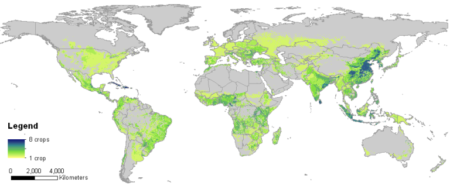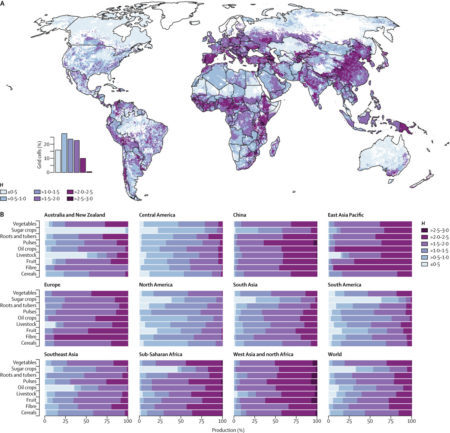I ran across a bunch of nice crop maps on the internet 1, so I made a GIF for you (click on it to get it cycling).
You’re welcome.
I’m reliably informed the source is Monfreda et al. (2008). You can download the data in multiple formats, but I don’t think I’ve ever seen the headline maps displayed all together as The Decolonial Atlas has done, albeit without attribution, which is naughty.
Anyway, people have obviously taken the trouble to download and play around with the data. For example, they have been ably mashed up by Bioversity to get a global crop diversity map.

Which, in turn, it is instructive to compare with the one from the Lancet Planetary Health map we blogged about a few days ago.

But which dataset to use to do this kind of stuff? Monfreda’s is only one of many.
I see that we now, after a long wait, have WordClim 2, thanks to the work of our friend Robert Hijmans and his colleagues. 2 Is it too much to hope for that he’ll now turn his hand to producing the definitive crop distribution dataset? 3 Maybe something for the CGIAR’s Big Data Platform, just launched, to think about organizing, convening, and/or inspiring.
- Though there are some strange things about a couple of them. Check out the shea one, for example.
- Not to mention climate surfaces going back 20,000 years.
- Yes, we’ve blogged about this before. More than once.

Not a bad idea Luigi… I would say that the big difference in what you could do today and what the current set of global crop maps offer is that today there’s a lot more very high-resolution satellite imagery. I suppose that you could use “big data” & machine learning to find individual crop patterns in all that data. I think that some people are doing this kind of thing, but it’s private sector stuff. The global crop maps rely too heavily on data from surveys and censuses, and all the problems that come with those in terms of standardizing across countries.
Well, this may be one way to go.
Compiling the best expert information with subnational statistics as a first cut and then using that to guide further detailed mapping with remote sensing/big data.
I’d like to see more efforts in crowdsourcing for crop mapping as well.